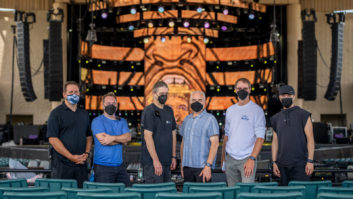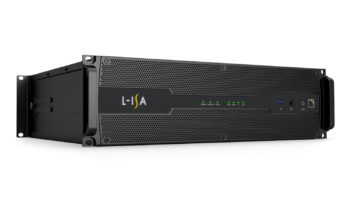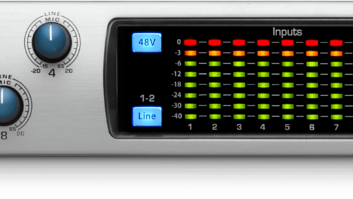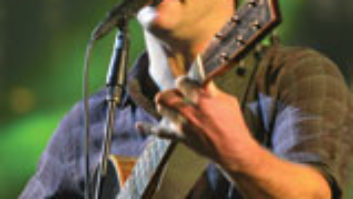For more than a dozen years, the Dave Matthews Band has consistently ranked as one of the top-grossing touring acts in the U.S. Mix caught up with the band’s successful 2007 tour at the Shoreline Amphitheater (Mountain View, Calif.) in late September. During this particular cross-country jaunt, Matthews and bandmates Stefan Lessard (bass), Boyd Tinsley (electric violin), Carter Beauford (drums) and LeRoi Moore (sax), as well as touring regulars Butch Taylor (keyboards) and Rashawn Ross (trumpet) played consistently lengthy sets, including more than 70 songs culled from the band’s vast catalog of original material and unconventional covers.
PRE-SHOW PREP
The band’s longtime touring company, Pro Media/UltraSound (Hercules, Calif.), arrived late in the afternoon, but everything appeared in prime working order when opening act Stephen Marley took the stage and most of the 22,000 fans had found their seats. In addition to the bevy of tapers, which Matthews allows, recording engineer Joe Lawlor positioned himself in monitor world to man the rack of Tascam MX-2424 hard drive recorders that comprise Matthews’ mobile recording rig. As with every DMB show, Lawlor would record the entire set for archival purposes and possible future use.
“The recording setup gets a transformer-isolated split from the stage and runs through 48 channels’ worth of API 212L preamps to the Tascams,” explains Jeff Thomas, Matthews’ front-of-house engineer. “The hard drives get sent to the band’s archivist in Charlottesville [Va., the band’s hometown], where the individual tracks get bounced to multiple CD-Rs and are then stored in a climate-controlled vault.” Some of these songs wind up on the band’s Live Trax CD Series, the tenth volume of which came out in May 2007.
To power the band’s jazz-influenced, jam-heavy pop/rock hybrid, Thomas chose a line array system based on the Meyer Sound MILO self-powered loudspeakers — an upgrade from the Meyer MSL-10-based system they had used through 2004. Pro Media/UltraSound supplied the Shoreline show with twin arrays of 11 MILO 90 loudspeakers and one MILO 120 per side. Two stacks of eight Meyer Sound 700-HP subwoofers per side covered the low end, while three MSL-4s per side were used for sidefill offstage of the mains. Three CQ-2 loudspeakers handled front-fill coverage under the mains, and two UPJ-1P loudspeakers covered the center area in front of Matthews, who doesn’t stray far from the middle of the stage.
Thomas switched from the M3D-Sub cardioid subs to the 700-HP units last year, a change that better suits the band’s performance. “The band missed that sub feel and energy onstage,” says FOH system engineer Tom Lyon, of Pro Media/UltraSound. “Fortunately, we had another system out with Phil Lesh that had our 700-HPs, and they were having the opposite problem: too much sub energy onstage! So the two tours switched their subwoofer complements while they were both in the Boston area the same day.”
Coincidentally, the installation division of the Bay Area sound company recently installed a new JBL VerTec 4888 system for Shoreline’s lawn delays, programmed and tuned by Lyon. “Knowing that system had already been configured and optimized ‘the Ultra way,’ it was one less thing to worry about during a hectic, late load-in,” he says.
THE BAND TAKES THE STAGE
At the main FOH position, Thomas works on a Digidesign VENUE D-Show digital mixing console; their previous console, a Gamble EX-56 modified by Pro Media/UltraSound chief engineer Geoff Peters and rental/touring director Derek Featherstone, resides next to the VENUE and is reserved for opening act Marley. Thomas uses about 40 inputs divided into eight subgroups. The VENUE system handles most of the onboard processing; beyond that, he uses a Bomb Factory BF76 compressor plug-in for vocal subgroup and subgroup bus compression. He enlists a Joe Meek SC2 compressor plug-in for dynamics and Digidesign’s ReVibe and Reverb One plug-ins for effects. For vocals, he uses the Serato compressor plug-in for de-essing and “de-pinging.”
Though Thomas handles dynamic control and EQ at FOH, several of the musicians provide additional effects from the stage. Eventide DSP-4000s and TC Electronic M-5000s are used for the bass, violin and saxophone players, all handled by either the musicians or their techs.
Thomas uses a fairly straightforward miking scheme for the highly skilled ensemble. He equips drummer Beauford’s kit with DPA 4021s for the toms, Sennheisers for the kick and snare, a Neumann KM 184 for the hi-hat, a Shure VP88 for the overheads, and AKG C 414s and a Shure KSM 137 for chimes, toys and other percussion. Electric guitar gets miked with a Shure SM7B, sax gets an AKG C 4000 B on the top and bottom, and flute and trumpet are miked with Shure Beta 98 models. Violin, acoustic guitar, bass and keyboards run direct. As for Matthews’ distinct vocals, the mic of choice these days is a Neumann KMS 140. “We use it for its neutral coloration and built-in highpass filter,” says Thomas.
Another unique component of the DMB audio arsenal, Thomas uses the BSS Audio SoundWeb system with EAW SmaartLive Version 5.4 software to adjust EQ and tune the P.A. in multiple zones. Thomas uses SoundWeb primarily as an analysis microphone switcher for the Smaart software. “Along with the SoundWeb working as a switcher, we use UltraSound-modified Sennheiser RF transmitters and receivers to make our four analysis microphones wireless,” Thomas adds. “They then can be easily placed in the discrete P.A. array zones and utilized during the show. I also have Smaart Version 6 fed from my cue bus on the console so I can cue selected channels and see their individual spectrum, or the master bus and see the overall tonal spectrum.”
MANNING THE ONSTAGE SOUND
Just as Thomas and crew continually work to improve the sound quality at FOH, monitor engineer Ian Kuhn looks for new ways to strengthen their wireless system. He recently incorporated Professional Wireless’ IAS software into his regime, which allows his team to coordinate all of the RF gear used on the tour, as well as improve RF transmission. Matthews began using Sensaphonics 2X IEMs in 1997; now, the entire band wears them. Kuhn uses both Sennheiser and Shure wireless systems to cater to the musicians’ individual sonic preferences. While the band wears in-ear monitors exclusively, they also carry a few Meyer Sound USM-1 wedges, powered by Crest 7001 amplifiers, to accommodate the opening act, as well as any guest musicians who might join in.
Kuhn mixes primarily on a Yamaha PM1D, while audio crew chief Lonnie Quinn mixes violinist Tinsley on a Yamaha DM2000. Aside from the Yamahas’ onboard processing and effects, Kuhn uses Aphex 1788 mic pre’s for some of the key inputs. As for monitor mix requirements, bandmembers keep their preferences reasonably simple. “As with most musicians, each of the guys has a specific preferred mix that we strive to meet,” says Kuhn. “Dave leans toward a full band mix, with his vocal and guitar peeking out over the top.”
Trumpeter Ross, who joined the lineup this year, adds a new challenge to Kuhn’s regular duties: a mini horn section. “It’s been quite enjoyable mixing the new ‘horn section,’ finding ways to layer into the mix the new parts they’re coming up with nightly,” he says.
WHAT WILL THEY PLAY NEXT?
Matthews’ continually rotating set list also keeps Kuhn and the rest of the crew on their toes. “We use the ‘Songs and Cues’ portion of the [Production Consultants Guild] Master Tour Database software to track our cues for all the songs the band has ever played,” says Kuhn. “Designed to replace a stack of note cards with hand-written cues, it places the song records in order of the evening’s set list and allows for easy navigation and recalling between songs.” The software also keeps track of every set list the band has ever done — information that avid Matthews fans love to study.
With more than a decade of experience under most of their belts, the longtime audio team continues to stay challenged by this group of musicians. “After 12-plus years of mixing monitors for these guys, it is still very fresh,” says Kuhn. “The band is incredibly spontaneous in their performances, and I’m honored to be a part of it.”
Heather Johnson is a Mix contributing editor.
Additional Audio Crew
FOH Tech: Greg Botimer
Monitor System Tech: Tony Norris
P.A. Tech: Jeff Child
For a full list of the band’s gear, visit http://road.davematthewsband.com/bandgear.html.




